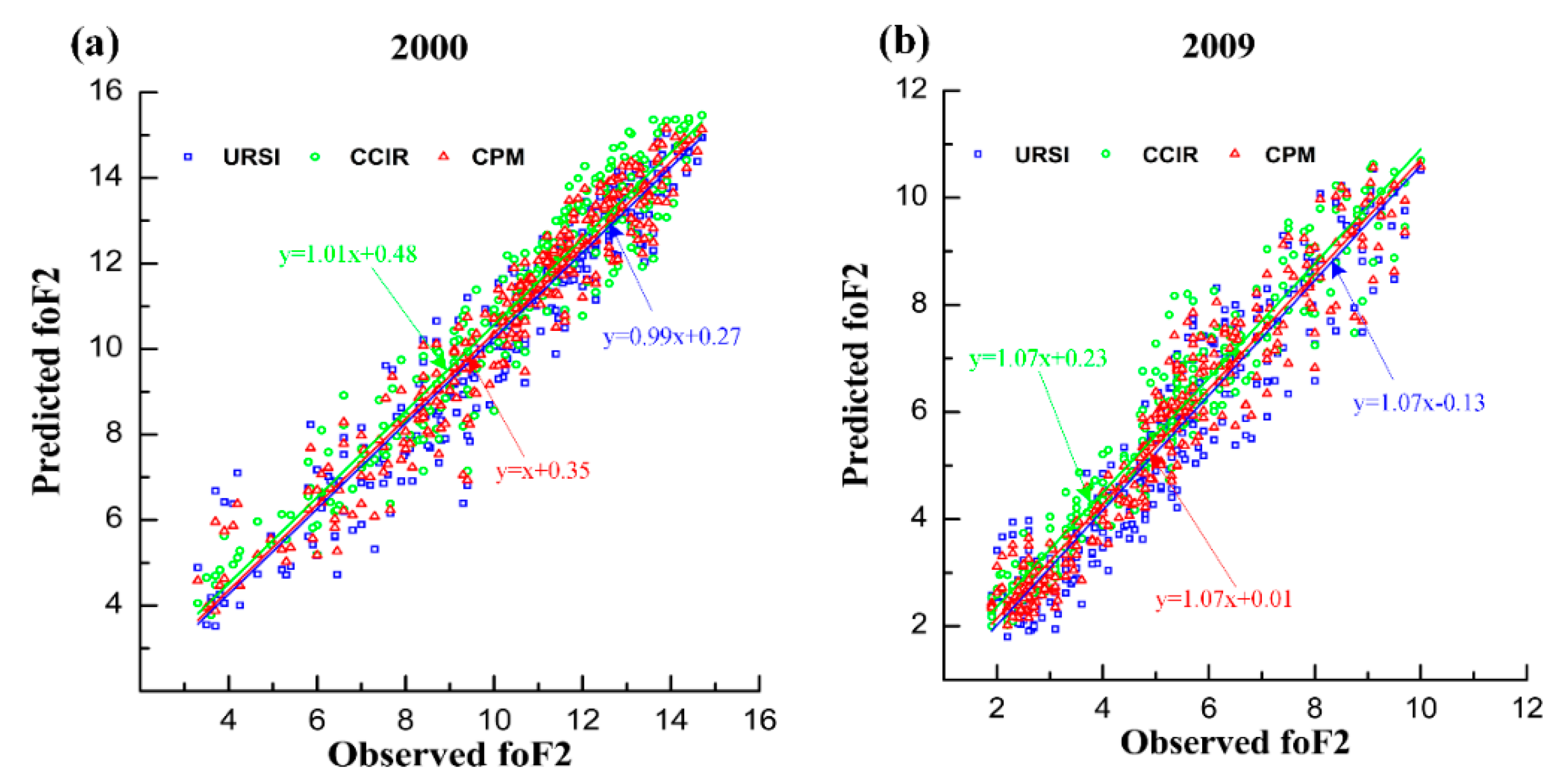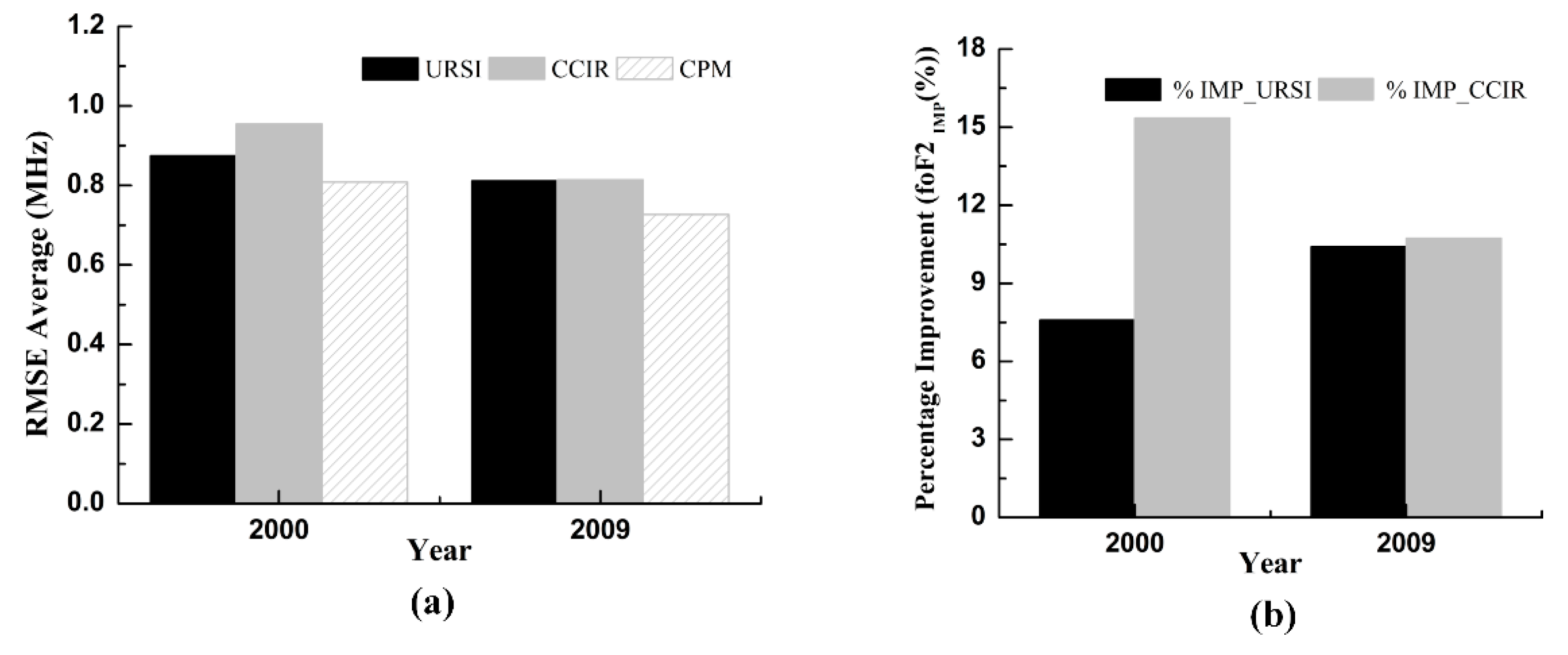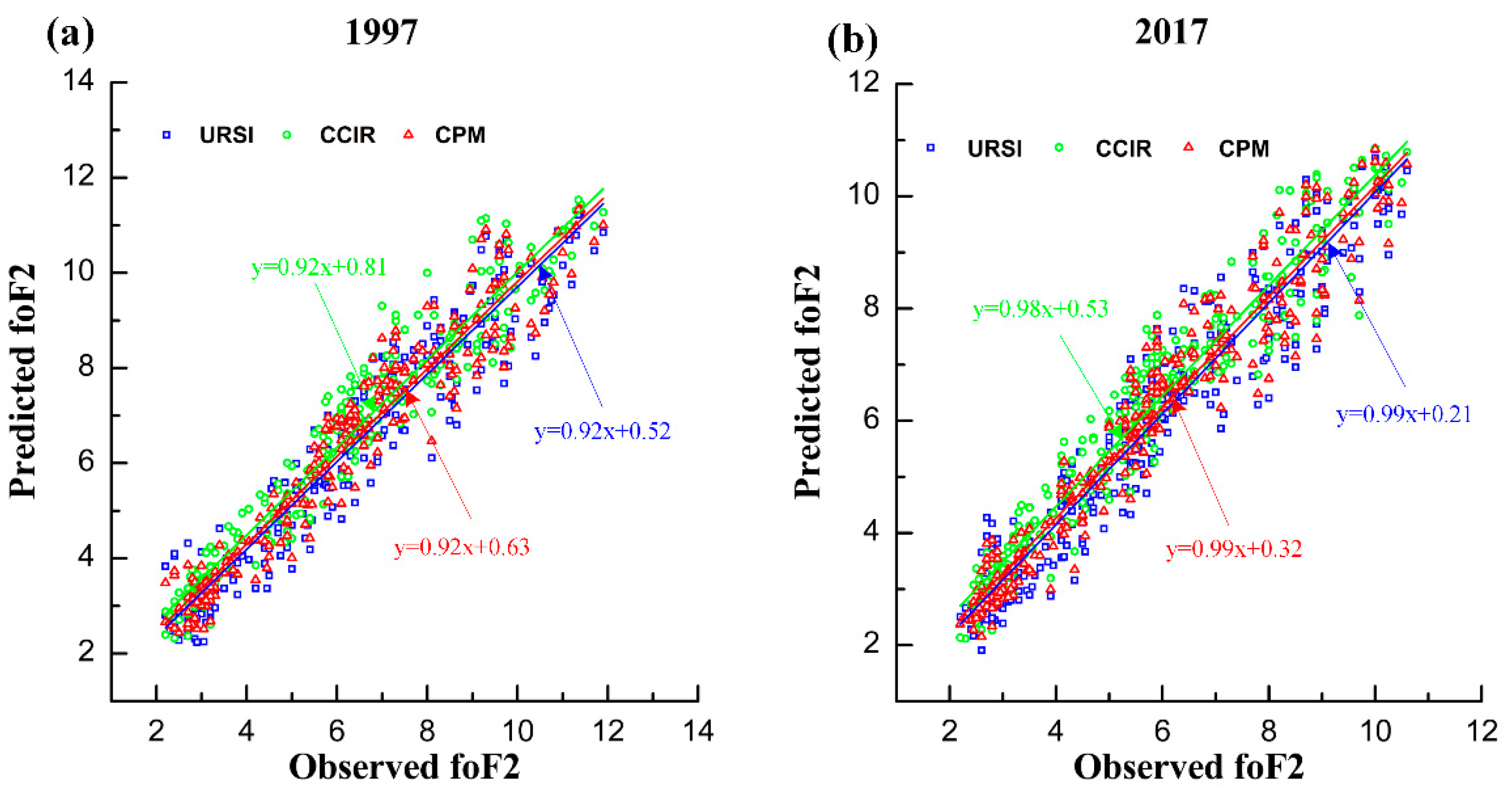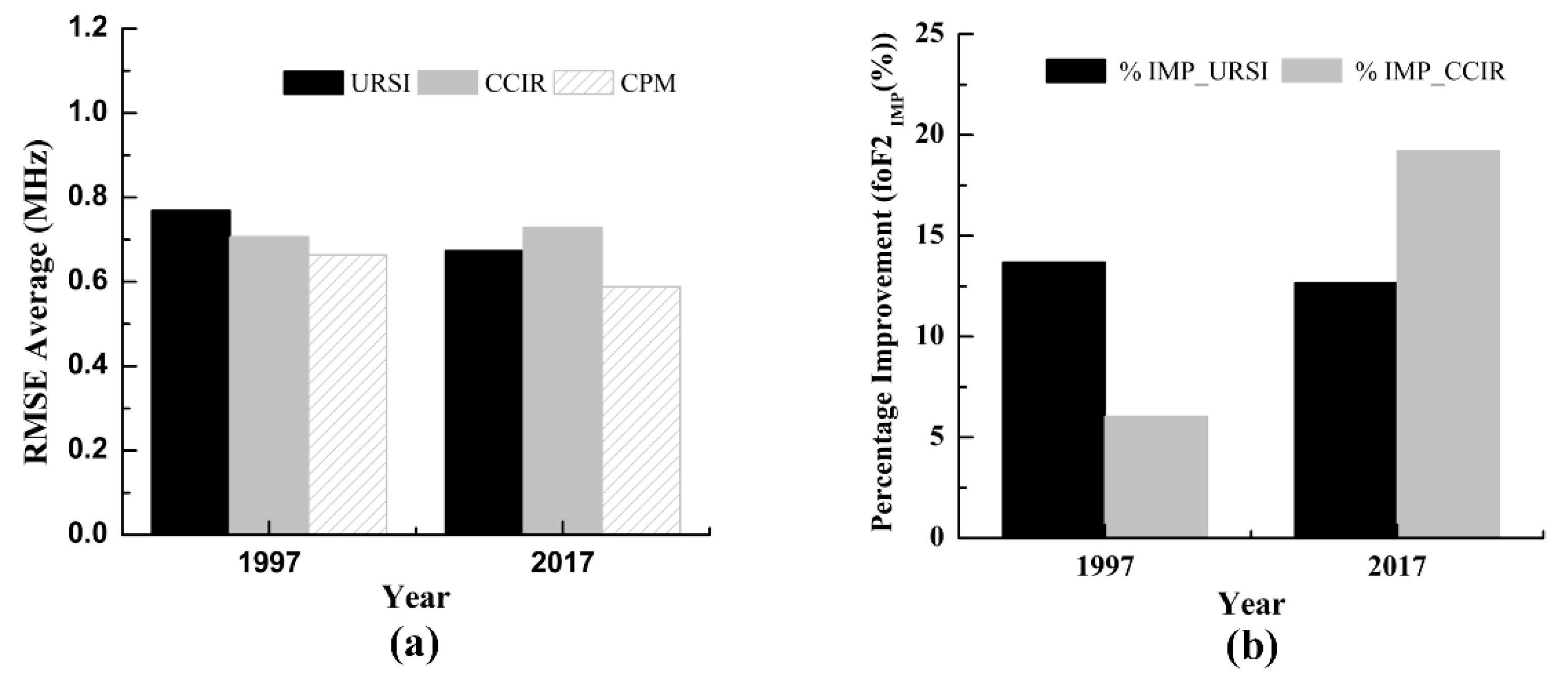A Combination Prediction Model of Long-Term Ionospheric foF2 Based on Entropy Weight Method
Abstract
1. Introduction
2. Data and Methodology
2.1. Database
2.2. Methodology
3. Results and Discussions
3.1. The Performance of Different Prediction Models within the Calibration Period
3.2. The Performance of Different Prediction Models outside the Calibration Period
4. Conclusions
Author Contributions
Funding
Conflicts of Interest
References
- Wang, J.; Bai, H.; Huang, X.; Cao, Y.; Chen, Q.; Ma, J. Simplified Regional Prediction Model of Long-Term Trend for Critical Frequency of Ionospheric F2 Region over East Asia. Appl. Sci. 2019, 9, 3219. [Google Scholar] [CrossRef]
- Wang, J.; Ma, J.; Huang, X.; Bai, H.; Chen, Q.; Cheng, H. Modeling of the ionospheric critical frequency of the F2 layer over Asia based on modified temporal-spatial reconstruction. Radio Sci. 2019, 54, 680–691. [Google Scholar]
- Wichaipanich, N.; Hozumi, K.; Supnithi, P.; Tsugawa, T. A comparison of neural network-based predictions of foF2 with the IRI-2012 model at conjugate points in Southeast Asia. Adv. Space Res. 2017, 59, 2934–2950. [Google Scholar] [CrossRef]
- Bai, H.; Fu, H.; Wang, J.; Ma, K.; Wu, T.; Ma, J. A prediction model of ionospheric foF2 based on extreme learning machine. Radio Sci. 2018, 53, 1292–1301. [Google Scholar] [CrossRef]
- Wintoft, P.; Cander, L.R. Twenty-four hour predictions of foF2 using time delay neural networks. Radio Sci. 2000, 35, 395–408. [Google Scholar]
- Rawer, K.; Lincoln, J.V.; Conkright, R.O. International Reference Ionosphere—IRI 79; Report UAG-82; World Data Center A for Solar-Terrestrial Physics: Boulder, CO, USA, 1981. [Google Scholar]
- Bilitza, D. International Reference Ionosphere: IRI-90; National Space Science Data Center: Greenbelt, MD, USA, 1990; pp. 52–65. [Google Scholar]
- Bilitza, D. International Reference Ionosphere 2000. Radio Sci. 2001, 36, 261–275. [Google Scholar] [CrossRef]
- Bilitza, D.; Reinisch, B.W. International reference ionosphere 2007: Improvements and new parameters. Adv. Space Res. 2008, 42, 599–609. [Google Scholar] [CrossRef]
- Bilitza, D.; Altadill, D.; Zhang, Y.; Mertens, C.; Truhlik, V.; Richards, P.; McKinnell, L.-A.; Reinisch, B. The International Reference Ionosphere 2012—A model of international collaboration. J. Space Weather Spac. 2014, 4, A07. [Google Scholar] [CrossRef]
- Bilitza, D.; Altadill, D.; Truhlik, V.; Shubin, V.; Galkin, I.; Reinisch, B.; Huang, X. International Reference Ionosphere 2016: From ionospheric climate to real-time weather predictions. Space Weather 2017, 15, 418–429. [Google Scholar] [CrossRef]
- Bilitza, D. IRI the International Standard for the Ionosphere. Adv. Radio Sci. 2018, 16, 1–11. [Google Scholar] [CrossRef]
- Williscroft, L.A.; Poole, A.W.V. Neural networks, foF2, sunspot number and magnetic activity. Geophys. Res. Lett. 1996, 23, 3659–3662. [Google Scholar] [CrossRef]
- Poole, A.W.V.; Mckinnell, L.A. On the predictability of foF2 using neural networks. Radio Sci. 2000, 35, 225–234. [Google Scholar] [CrossRef]
- Oyeyemi, E.O.; Poole, A.W.V. Towards the development of a new global foF2 empirical model using neural networks. Adv. Space Res. 2004, 34, 1966–1972. [Google Scholar] [CrossRef]
- Oyeyemi, E.O.; Poole, A.W.V.; Mckinnell, L.A. On the global model for foF2 using neural networks. Radio Sci. 2005, 40, 1–15. [Google Scholar] [CrossRef]
- Oyeyemi, E.O.; Mckinnell, L.A.; Poole, A.W.V. Near-real time foF2 predictions using neural networks. J. Atmos. Sol.-Terr. Phys. 2006, 68, 1807–1818. [Google Scholar] [CrossRef]
- Oyeyemi, E.O.; Mckinnell, L.A. A new global F2 peak electron density model for the International Reference Ionosphere (IRI). Adv. Space Res. 2008, 42, 645–658. [Google Scholar] [CrossRef]
- Athieno, R.; Jayachandran, P.T.; Themens, D.R. A Neural Network based foF2 model for a single station in the polar cap. Radio Sci. 2017, 52, 784–796. [Google Scholar] [CrossRef]
- Ban, P.P.; Sun, S.J.; Chen, C.; Zhao, Z.W. Forecasting of low-latitude storm-time ionospheric foF2 using support vector machine. Radio Sci. 2011, 46, 1–9. [Google Scholar] [CrossRef]
- Chen, C.; Wu, Z.S.; Sun, S.J.; Ban, P.P.; Ding, Z.H.; Xu, Z.W. Forecasting the ionospheric foF2, parameter one hour ahead using a support vector machine technique. J. Atmos. Sol.-Terr. Phys. 2010, 72, 1341–1347. [Google Scholar] [CrossRef]
- CCIR. Comite Consultatif International des Radio Communications; Reports 340-1 and 340-6; International Telecommunication Union: Geneva, Switzerland, 1996. [Google Scholar]
- Rush, C.; Fox, M.; Bilitza, D.; Davies, K.; McNamara, L.; Stewart, F.; Pokempner, M. Ionospheric mapping—An update of foF2 coefficients. Telecommun. J. 1989, 56, 179–182. [Google Scholar]
- Bilitza, D.; McKinnell, L.A.; Reinisch, B.; Fuller-Rowell, T. The International Reference Ionosphere today and in the future. J. Geod. 2011, 85, 909–920. [Google Scholar] [CrossRef]
- Mandrikova, O.V.; Fetisova, N.V.; Polozov, Y.A.; Solovev, I.S.; Kupriyanov, M.S. Method for modeling of the components of ionospheric parameter time variations and detection of anomalies in the ionosphere. Earth Planets Space 2015, 67, 131. [Google Scholar] [CrossRef]
- Mandrikova, O.; Polozov, Y.; Fetisova, N.; Zalyaev, T. Analysis of the dynamics of ionospheric parameters during periods of increased solar activity and magnetic storms. J. Atmos. Sol.-Terr. Phys. 2018, 181, 116–126. [Google Scholar] [CrossRef]
- Gordiyenko, G.I.; Yakovets, A.F. Comparison of midlatitude ionospheric F region peak parameters and topside Ne profiles from IRI-2012 model prediction with ground-based ionosonde and alouette II observations. Adv. Space Res. 2017, 60, 461–474. [Google Scholar] [CrossRef]
- Wichaipanich, N.; Supnithi, P.; Ishii, M.; Maruyama, T. Ionospheric variation at Thailand equatorial latitude station: Comparison between observations and IRI-2001 model predictions. Adv. Space Res. 2010, 45, 284–293. [Google Scholar] [CrossRef]
- Zakharenkova, I.E.; Krankowski, A.; Bilitza, D.; Cherniak, I.V.; Shagimuratov, I.I.; Sieradzki, R. Comparative study of fof2 measurements with IRI-2007 model predictions during extended solar minimum. Adv. Space Res. 2013, 51, 620–629. [Google Scholar] [CrossRef][Green Version]
- Zhang, M.L.; Shi, J.K.; Wang, X.; Shang, S.P.; Wu, S.Z. Ionospheric behavior of the F2 peak parameters foF2 and hmF2 at Hainan and comparisons with IRI model predictions. Adv. Space Res. 2007, 39, 661–667. [Google Scholar] [CrossRef]
- Zhang, M.L.; Shi, J.K.; Wang, X.; Wu, S.Z.; Zhang, S.R. Comparative study of ionospheric characteristic parameters obtained by DPS-4 digisonde with IRI-2000 for low latitude station in China. Adv. Space. Res. 2004, 33, 869–873. [Google Scholar] [CrossRef]
- Bai, H.; Feng, F.; Wang, J.; Wu, T. Nonlinear dependence study of ionospheric F2 layer critical frequency with respect to the solar activity indices using the mutual information method. Adv. Space Res. 2019, 64, 1085–1092. [Google Scholar] [CrossRef]
- Huang, S.; Ming, B.; Huang, Q.; Leng, G.; Hou, B. A case study on a combination NDVI forecasting model based on the entropy weight method. Water Resour. Manag. 2017, 31, 3667–3681. [Google Scholar] [CrossRef]
- Cheng, L.; Zhang, Y.; Suo, L.; Shen, S.; Fang, F.; Jin, L. Short-term Cooling, Heating and Electrical Load Forecasting in Business Parks Based on Improved Entropy Method. In Proceedings of the 36th Chinese Control Conference, Dalian, China, 26–28 July 2017. [Google Scholar]
- Zhang, Q.Y.; Zhu, X.M.; Xu, K. Combination forecasting on software reliability based on entropy weight. In Proceedings of the International Conference on Electronic and Mechanical Engineering and Information Technology, EMEIT 2011, Harbin, China, 12–14 August 2011. [Google Scholar]
- Shannon, C.E. A mathematical theory of communication. Bell Syst. Tech. J. 1948, 27, 379–423. [Google Scholar] [CrossRef]
- Li, Y.; Wang, D.F.; Han, P. Selective ensemble using discrete differential evolution algorithm for short-term load forecasting. In Proceedings of the IEEE 2009 International Conference on Machine Learning and Cybernetics, Baoding, China, 12–15 July 2009. [Google Scholar]
- Chen, Y.; Li, Y. Entropy-Based Combining Prediction of Grey Time Series and Its Application. In Proceedings of the 12th International Conference on Intelligent Computation Technology & Automation, Xiangtan, China, 10–11 October 2009. [Google Scholar]
- Huang, S.; Chang, J.; Leng, G.; Huang, Q. Integrated index for drought assessment based on variable fuzzy set theory: A case study in the Yellow River Basin, China. J. Hydrol. 2015, 527, 608–618. [Google Scholar] [CrossRef]
- Lu, J.P.; Wei, C.; Wu, J.; Wei, C.W. TOPSIS Method for Probabilistic Linguistic MAGDM with Entropy Weight and Its Application to Supplier Selection of New Agricultural Machinery Products. Entropy 2019, 21, 953. [Google Scholar] [CrossRef]
- Krstanovic, P.F.; Singh, V.P. Evaluation of rainfall networks using entropy: I. Theoretical development. Water Resour. Manag. 1992, 6, 279–293. [Google Scholar] [CrossRef]




© 2020 by the authors. Licensee MDPI, Basel, Switzerland. This article is an open access article distributed under the terms and conditions of the Creative Commons Attribution (CC BY) license (http://creativecommons.org/licenses/by/4.0/).
Share and Cite
Bai, H.; Feng, F.; Wang, J.; Wu, T. A Combination Prediction Model of Long-Term Ionospheric foF2 Based on Entropy Weight Method. Entropy 2020, 22, 442. https://doi.org/10.3390/e22040442
Bai H, Feng F, Wang J, Wu T. A Combination Prediction Model of Long-Term Ionospheric foF2 Based on Entropy Weight Method. Entropy. 2020; 22(4):442. https://doi.org/10.3390/e22040442
Chicago/Turabian StyleBai, Hongmei, Feng Feng, Jian Wang, and Taosuo Wu. 2020. "A Combination Prediction Model of Long-Term Ionospheric foF2 Based on Entropy Weight Method" Entropy 22, no. 4: 442. https://doi.org/10.3390/e22040442
APA StyleBai, H., Feng, F., Wang, J., & Wu, T. (2020). A Combination Prediction Model of Long-Term Ionospheric foF2 Based on Entropy Weight Method. Entropy, 22(4), 442. https://doi.org/10.3390/e22040442





